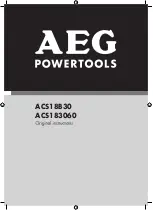
16 ENGLISH
Burrowing and parallel-to-grain cuts
CAUTION:
•
Burrowing and parallel-to-grain cuts may only be
carried out by persons with special training. The
possibility of kickback presents a risk of injury.
►
Fig.25
Perform parallel-to-grain cuts at as shallow an angle as
possible. Carry out the cut as carefully as possible, as
the spike bumper cannot be used.
Felling
CAUTION:
•
Felling work may only be performed by trained
persons. The work is hazardous.
Observe local regulations if you wish to fell a tree.
►
Fig.26:
1.
Felling area
— Before starting felling work, ensure that:
(1) Only persons involved in the felling operation
are in the vicinity;
(2) Any person involved has an unhindered path
of retreat through a range of approximately
45 ° either side of the felling axis. Consider
the additional risk of tripping over electrical
cables;
(3) The base of the trunk is free of foreign
objects, roots and ranches;
(4) No persons or objects are present over a
distance of 2 1/2 tree lengths in the direction
in which the tree will fall.
— Consider the following with respect to each tree:
•
Direction of lean;
•
Loose or dry branches;
•
Height of the tree;
•
Natural overhang;
•
Whether or not the tree is rotten.
— Consider the wind speed and direction. Do not
carry out felling work if the wind is gusting strongly.
— Trimming of root swellings: Begin with the largest
swellings. Make the vertical cut first, then the
horizontal cut.
►
Fig.27
— Cut a scarf: The scarf determines the direction in
which the tree will fall, and guides it. It is made
on the side towards which the tree is to fall. Cut
the scarf as close to the ground as possible. First
make the horizontal cut to a depth of 1/5 -1/3 of
the trunk diameter. Do not make the scarf too
large. Then make the diagonal cut.
— Cut any corrections to the scarf across its entire
width.
►
Fig.28
— Make the back cut a little higher than the base cut
of the scarf. The back cut must be exactly horizon-
tal. Leave approximately 1/10 of the trunk diameter
between the back cut and the scarf.
The wood fibers in the uncut trunk portion act as
a hinge. Do not cut right through the fibers under
any circumstances, as the tree will otherwise fall
unchecked. Insert wedges into the back cut in time.
— Only plastic or aluminum wedges may be used to
keep the back cut open. The use of iron wedges is
prohibited.
— Stand to the side of the falling tree. Keep an area
clear to the rear of the falling tree up to an angle of
45 ° either side of the tree axis (refer to the " felling
area " figure). Pay attention to falling branches.
— An escape path should be planned and cleared
as necessary before cuts are started. The escape
path should extend back and diagonally to the rear
of the expected line of fall as illustrated in figure.
►
Fig.29:
1.
Felling direction
2.
Danger zone
3.
Escape route
MAINTENANCE
CAUTION:
•
Always be sure that the tool is switched off and
unplugged before attempting to perform inspec-
tion or maintenance.
•
Always wear gloves when performing any
inspection or maintenance.
•
Never use gasoline, benzine, thinner, alcohol
or the like. Discoloration, deformation or cracks
may result.
Carry out the maintenance work described below at
regular intervals. Warranty claims will be accepted only
if these operations have been performed regularly and
properly.
Only maintenance work described in this instruction
manual may be performed by the user. Any other work
must be carried out by DOLMAR authorized service
centers.
Cleaning the chain saw
Clean the saw regularly with a clean rag. The handles,
in particular, must be kept free of oil.
Checking the plastic housing
Carry out regular visual inspections of all parts of the
housing. If any parts are damaged, have them repaired
immediately and properly in DOLMAR authorized ser
-
vice centers.
Sharpening the saw chain
CAUTION:
•
Always withdraw the mains plug and wear
safety gloves when performing work on the saw
chain.
►
Fig.30
Sharpen the saw chain when:
— Mealy sawdust is produced when damp wood is
cut;
— The chain penetrates the wood with difficulty, even
when heavy pressure is applied;
— The cutting edge is obviously damaged;
Содержание 0088381808088
Страница 2: ...1 2 1 1 1 2 1 3 1 2 Fig 1 Fig 2 Fig 3 Fig 4 Fig 5 Fig 6 Fig 7 Fig 8 2 ...
Страница 4: ...1 2 3 5 4 1 2 3 1 3 2 1 1 A B A B Fig 17 Fig 18 Fig 19 Fig 20 Fig 21 Fig 22 Fig 23 Fig 24 4 ...
Страница 6: ...30 1 2 1 1 1 2 Fig 33 Fig 34 Fig 35 Fig 36 Fig 37 Fig 38 Fig 39 Fig 40 6 ...
Страница 115: ...115 ...
















































